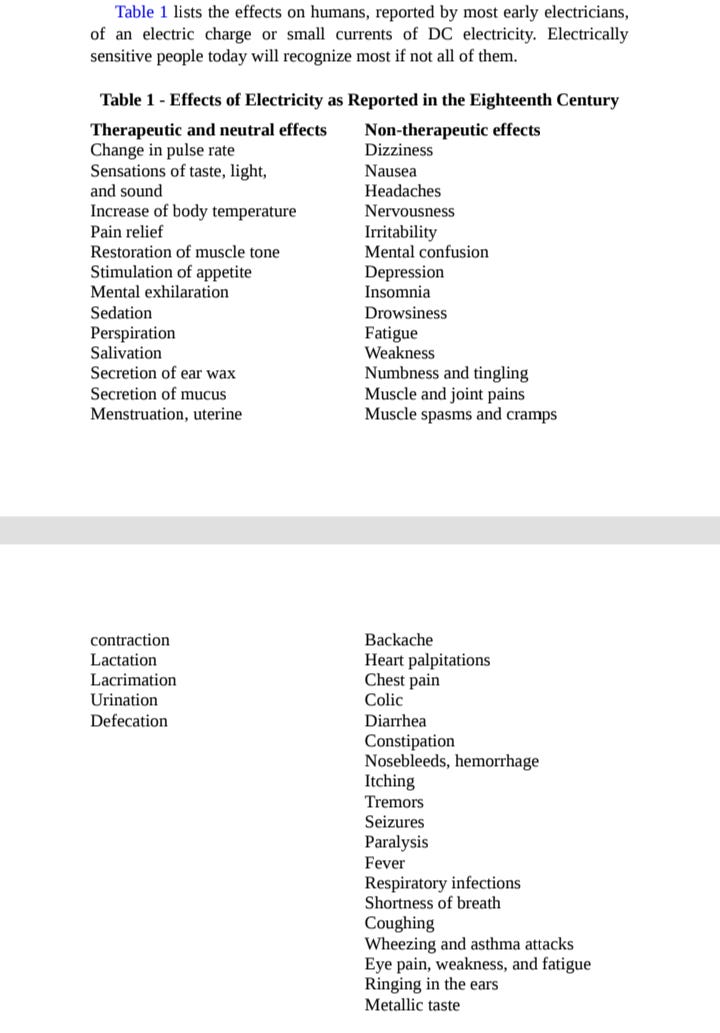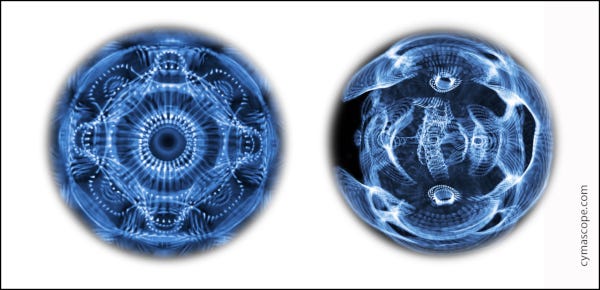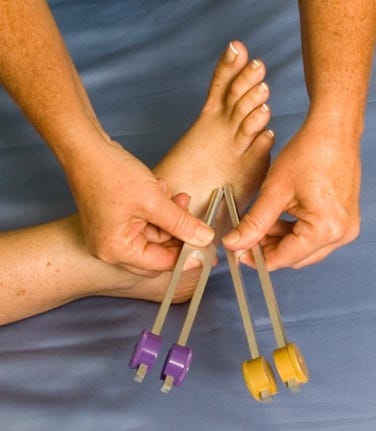EMF and random illness vs dietary triggers vs smoking & formaldehyde -> which caused the symptoms?
Book, The Invisible Rainbow, Arthur Firstenberg, 2017, via Psinergist on Telegram
I found a trove of ebooks collected by Psinergists and started reading The Invisible Rainbow, by Arthur Firstenberg, 2017; to buy: (BarnesAndNoble) or (pdf). Just the first few chapters made me realize that my odd symptoms with so many possible causes likely include how much screen time I spent that day — not just what I ate — and that I need to do better at reducing EMF exposure too. Racing or irregular heartrate, light and sound sensitivity, nausea and vomiting, irritability, anxiety, brain fog, …. that might all be following a day with intense screen time rather than only being about what I ate/meds/supplements/topicals.
The treasure trove: Anthony Crawford: For the reminder and for newcomers, the Psinergy Archive on Mega is located here. 4+ months of video archive and research files. Thank you all for the shares.
Psinergy Mega Archive — The password is: ThankYouSabrina!!
https://mega.nz/#P!AgDvXSAVAEO_izd0tpqRuYkpzXuJ1KeX1r4V1OvqxSirprmfhfwM6ug2kx_baGCvLuTL7GWvPJ9CDSzQUtKJyJNJizZpz-WwFHhfVNkeelDe4MNBYZnIHg via (Telegram)
Is my racing heart rate sulfate or salicylate or other food sensitivities or was it too much screen time yesterday? I had left my cellphone on last night (*yesterday night now) without an EMF proof cover over it and I usually try to turn it off or cover it. A Faraday cage for the router and turning it off at night would also be simple solutions. It is strong enough that I can use the internet while sitting outside if I am still near the house. Taking a social media break to read paper books was a vacation from EMF too.

List of known therapeutic benefits of electricity, low doses usually, and negative side effects. It was known that there is huge variation in individual sensitivity to electricity with some more sensitive and others insensitive to it, even blocking a signal in a circle of people holding hands to feel the static electrical flow. Electricity became like a party game in the 1800s.

The following excerpts describe two types of illnesses linked to the introduction of electricity and telegraph machines. The telegraph operators made the connection between their symptoms and their electricity exposure but doctors at the time still thought of electricity as something used as a medical treatment for the benefit of patients — not something dangerous that might be causing harm. Margaret Abigail Cleaves, M.D. (1848-1917) described her own case of ‘neurasthenia’ which started after her switch to moving to a bigger city and in the next years started using electricity as a therapy tool for her gynecology and psychiatry patients. She never made the connection between her worsening health and her choice of career paths or her move to ‘modern’ electrified city.
Arthur Firstenberg uses the word sledgehammer to describe early ‘therapeutic’ use of electricity, however more delicate use did benefit people including deaf people whose hearing was restored with very low doses of electricity pulsed onto parts of their ear for only a few minutes. Electroshock ‘therapy’ in psychiatry led to significant harm and the movie One Flew Over a Cuckoo’s Nest - the take home lesson from that movie might have been that jail would have been a better choice than lying to get into a psych ward instead - and have your brain electrified. *based on memory of the story.
From The Invisible Rainbow: “In 1890 she had moved to the big city, where she had opened a private practice in gynecology and psychiatry. It was not until 1894, at the age of 46, that she was diagnosed with neurasthenia. What was new was her heavy exposure to electricity: she had begun to specialize in electro therapy. Then, in 1895, she opened the New York Electro-Therapeutic Clinic, Laboratory, and Dispensary, and within a matter of months experienced what she termed her “complete break.”” (p 60, Firstenberg, 2017) […]
“Cleaves had chronic fatigue, poor digestion, headaches, heart palpitations and tinnitus. She found the sounds of the city unbearable. She smelled and tasted “phosphorus.” She became so sensitive to the sun that she lived in darkened rooms, able to go outdoors only at night. She gradually lost her hearing in one ear. She became so affected by atmospheric electricity that, by her sciatica, her facial pain, her intense restlessness, her feeling of dread, and her sensation “of a crushing weight bowing me to the earth,” she could predict with certainty 24 to 72 hours in advance that the weather was going to change. “Under the influence of oncoming electrical storms,” she wrote, “my brain does not function.”11
And yet through it all, suffering until the end of her life, she was dedicated to her profession, exposing herself day in and day out to electricity and radiation in their various forms. She was a founding and very active officer of the American Electro-Therapeutic Association. Her textbook on Light Energy taught the therapeutic uses of sunlight, arc light, incandescent light, fluorescent light, X-rays, and radioactive elements. She was the first physician to use radium to treat cancer.
How could she not have known? And yet it was easy. In her day as in ours, electricity did not cause disease, and neurasthenia—it had finally been decided—resided in the mind and emotions.
Other related illnesses were described in the late nineteenth and early twentieth centuries, occupational diseases suffered by those who worked in proximity to electricity. “Telegrapher’s cramp,” for example, called by the French, more accurately, “maltélégraphique” (“telegraphic sickness”) because its effects were not confined to the muscles of the operator’s hand. Ernest Onimus described the affliction in Paris in the 1870s. These patients suffered from heart palpitations, dizziness, insomnia, weakened eyesight, and a feeling “as though a vice were gripping the back of their head.” They suffered from exhaustion, depression, and memory loss, and after some years of work a few descended into insanity. In 1903, Dr. E. Cronbach in Berlin gave case histories for seventeen of his telegraphist patients. Six had either excessive perspiration or extreme dryness of hands, feet, or body. Five had insomnia. Five had deteriorating eyesight. Five had tremors of the tongue. Four had lost a degree of their hearing. Three had irregular heartbeats. Ten were nervous and irritable both at work and at home. “Our nerves are shattered,” wrote an anonymous telegraph worker in 1905, “and the feeling of vigorous health has given way to a morbid weakness, a mental depression, a leaden exhaustion... Hanging always between sickness and health, we are no longer whole, but only half men; as youths we are already worn out old men, for whom life has become a burden...our strength prematurely sapped, our senses, our memory dulled, our impressionability curtailed.” These people knew the cause of their illness. “Has the release of electrical power from its slumber,” asked the anonymous worker, “created a danger for the health of the human race?”12 In 1882, Edmund Robinson encountered similar awareness among his telegraphist patients from the General Post Office at Leeds. For when he suggested treating them with electricity, they “declined trying anything of the kind.” (pp 61-62, The Invisible Rainbow, Arthur Firstenberg, (pdf).
The information about sensitivity versus actually blocking a signal is interesting. It was found that people with a fever would block the electrical flow even though normally they wouldn’t block it. And oddly, the people who seemed more sensitive and had symptoms, didn’t necessarily worsen or die earlier than people who weren’t very sensitive to electricity — didn’t have negative symptoms.
This photo from the Vibrational Healing post written by John Reid was quite revealing - healthy cytoplasm in a normal cell has intricate repetitive patterns while a cancer cell has distorted patterns with less repetition - less ‘crystal structure’ probably. EMF exposure increases inflammation which makes oxidative stress that may lead to nutrient depletion and disruption of methylation cycles, which leads to changes in epigenetic control of the genes in the cell nucleus, and increasing acidic waste which changes the structured water and exclusion zones of the cell cytoplasm. These Cymaglyph images may be showing us the difference between crystalline water within a cell - very patterned, and a cell whose crystalline structure is distorted, no longer as consistently patterned in the layers of hexagonally linked water molecules.

Those pics are freaky. I would rather have the Cymaglyph of the healthy cells. Reminder though - since ‘cancer’ can spontaneously resolve - tumors shrink with no surgery or deadly chemicals or radiation - that means the freaky looking cell is not ‘an enemy’ as much as a sick cell that needs help.
See this recent repost from GreenMedInfo:
VIBRATIONAL HEALING: Biological Mechanisms Underpinning Sound Therapy & Music Medicine - GreenMedInfo, by J. S. Reid
Introduction The intent of this article is to provide an introduction to some of the many biological mechanisms advantageously activated by sound and music, collectively categorised as 'vibrational medicine'. Since the development of quantum physics in the twentieth century, discoveries made in medical physics reveal the body as a complex interplay of bi…
Briefly returning to the sulfate/salicylate/EMF question — It is helpful to write down or remember what your various symptoms feel like to help figure out what might be wrong in future repeats.
Sulfate sensitivity - in my learning that I was too acidic I had started taking an Epsom salt bath every morning and within just a week I was having definite sulfate symptoms and that feels like a panic attack, racing heart - scary. I switched to magnesium chloride baths and every 4-5 days had been what I found adequate in the past for magnesium needs. I have stopped using garlic and have reduced sulfur rich veggies but I still use onions daily. They have good fiber for our microbiome.
Salicylate sensitivity - lack of glycine seems a major issue along with being too acidic. Adding fish to my diet and sardines seems to have reduced my salicylate sensitivity maybe by providing more glycine than I had in my bean/nut diet. I am still restricting most of my favorite spices, berries and other salicylate rich foods, as my health or puffy leg problem is still not steadily better every day. Avoiding too much salt seems to be really important while I can eat a little of the spices without salt. Apple cider vinegar is something I haven’t retried but plan to. It can really help gut health, but if too old, it can add to symptoms, like the salicylate concentration increases, or it is simply spoiled and is adding negative probiotic species to the gut.
Salicylate symptoms: Instant gassiness seems to be a quick and obvious symptom for higher salicylate content meals and the puffy legs follow shortly after but also depends on the salt content. The congestion was a later symptom - like weeks of elevated levels without my realizing what the problem was (wild strawberry and raspberry season tipped my accumulated load to too much). My use of black cumin seed oil daily would have given me a large load of salicylates too and I have mostly use it as a tooth rinse now.
I love coffee, and instant coffee has more salicylates than fresh brewed - but any coffee is also quite acidic and has oxalates. I need to stop trying to enjoy a little coffee. Darn. I have also noticed that just one carbonated beverage is enough acidity or phosphorus to leave my with bad muscle cramps in the night. Taking the pH Adjust product helps but how much to use and when in relation to a meal is still a little tricky. We need acidity to digest a meal so the alkaline drink needs to be later. When I am organized I have a glass of water by my bed at night and a glass of the alkaline water so I can drink a little of whichever seems to be the need in the middle of the night.
Pomegranate and pomegranate peel do add to the salicylate sensitivity ~ accumulated load ~ but helps as a diuretic so I have found one serving, about 1/4-1/2 teaspoon of inner peel per day, or maybe two to be a good amount. While the racing heart rate is the most obvious sulfate symptom, salicylate excess adds to the puffy leg problem and can worsen congestion and ADHD symptoms.
I am still taking guaifenisin/Mucinex for fibromyalgia muscle knots and it seems to help. I realized though as I was bemoaning the odd ‘sudden’ sensitivity to spices and foods that I have eaten for years - that the question of What am I doing differently that might be increasing sensitivity? was an easy answer: high dose quaifenisin daily was a sudden new thing. Maybe something about the strategy is also increasing sensitivity to salicylates and other COX2 inibitor phytonutrients like quercetin, bromelain, and luteolin. The post Salicylate page updated gets into this. (Substack)
The EMF symptoms yesterday that seemed a little different than either of those two sets of problems but matched the book included significant light and sound sensitivity along with not being able to see well, not focusing normally, and somewhere in the text it mentioned pain at the back of the head - sometimes I get muscle knots at the base of my skull at the same time the racing heart rate that also occurs with EMF. I know I am sensitive and will get tachycardia from EMF because I slept in a room with a modem for a short while and kept waking up with racing heart/panicky. Like smiling and you feel better - anything that causes a racing heart rate may leave you feeling ‘panicky’ because the two feelings are associated in the brain. I talked to my family doctor at the time and she did and EKG or something and said my heart was fine so then I tried moving my bed elsewhere and the racing heart problem went away.
The list of EMF symptoms in Table 1, The Invisible Rainbow, (Arthur Firstenberg, 2017; to buy: BarnesAndNoble or pdf) also mentions ringing in the ears and that was also occurring a little yesterday. Joint pain, dizziness, etc, many of the symptoms on the list are part of my up and down health — and therefore I need to reduce my EMF exposure more.
My bad habit symptom list includes side effects of smoking medical marijuana and that is a source of formaldehyde, which in excess can also cause symptoms - eczema, dry itchy eyes like seasonal allergies, and chronically lead to low methyl Bs and epigenetic POTS (dizziness upon standing up). General stress can add to a formaldehyde excess and being low in methyl folate adds bby not being available to detoxify the formaldehyde.
Stress, formaldehyde, smoking, and pain hypersensitivity in teeth or other body parts.
Stress, smoking, and smog are all health hazards for the related reason of increased formaldehyde levels. We make formaldehyde endogenously when under stress, and it is produced in smoke and is found in bad air or in odors from new car smell, or new carpet or new vinyl shower curtains. Volatile chemicals off-gas from plastic products and molds can add a…
Health can be complicated but it is worth the effort. Can’t think, can’t digest, can’t hardly get out of bed from exhaustion and need darkened rooms and extreme quiet… that is no way to live — yet it is a modern norm for many people. Maybe it is the electricity. Maybe other stuff is adding to the symptom load.
The Power Couple Substack is a good EMF resource on this platform.
Disclaimer: This information is being provided for educational purposes within the guidelines of Fair Use and is not intended to provide individual health guidance.
Reference List
Arthur Firstenberg, The Invisible Rainbow - A History of Electricity and Life, 2017, AGBPress, paperback, 2020, Chelsea Green Publishing https://www.dropbox.com/scl/fi/6aktb6dz1g678zrfyy236/The-Invisible-Rainbow.pdf?rlkey=pzkrigkapwq37u9pv5plrbigr&dl=0 To buy: (BarnesAndNoble)








Hi Jen. First, thanks for promoting Arthur Firstenberg…I have been receiving his occasional email updates for years, and am glad to see him finally getting the exposure he deserves.
Some further Cheap Thoughts:
Unfortunately I live in a condo development and can count over a dozen wifi networks [just the ones I can see], which renders shielding my router and other EMR precautions moot. The electrosmog here is as bad as a “big city.”
RE: vibrational healing - as a retired church musician, I can attest to the power of highly-organized sound to positively affect people. I listen to Renaissance church music all day, every day; the difference between this music and the sounds of a construction site is the same as that between the Cymaglyph images you posted, and the effects on people are likely very similar.
RE: coffee - darn, indeed, but I have successfully switched to organic green tea, which has the distinct advantage of being loaded with EGCG.
Curious - what about your medical cannabis use creates formaldehyde, and what other things are sources of excess?
Cheers!
Extremely well written. Thanks Jennifer, your article was loaded with information I wouldn’t have ever known. I have a question : Acidic foods usually irritate the bladder and act as a diuretic... is this not a good way to combat fluid retention? I’ve suddenly noticed that I have developed fluid retention in a flash! Is pomegranate a diuretic?